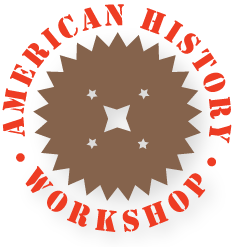Meeting the Client’s Challenge: Projects
American History Workshop prides itself on coming up with radically fresh approaches to our clients’ challenges. Perhaps a permanent exhibit turns out to be the wrong way to engage a predominantly local audience in a hot-button issue. Maybe conventional artifact labels will in effect keep visitors from actually looking at the objects displayed. Maybe the museum staff is not as well equipped as a community group to manage the complementary public programs. Could it be that an annual contest in local schools would supply key interpretive elements to a local museum’s program and thereby build up community involvement?
We put history learning first. To us, excellence in design, long-range planning, or in community partnerships is tremendously important, but these are tools for achieving the goals of engaging our diverse publics in connecting themselves to one another and to the shared past.
Every project is a new synthesis. Here’s a brief summary of what we’ve learned in some of our most challenging projects:
Lower East Side Tenement Museum
How can we balance the dramatic power of individual family sagas with the desire to provide visitors with an understanding of the role of immigrant working-class New Yorkers in making America’s largest city? Interpretation at LESTM first began with inventing hypothetical composite families, but then solid historical research – in municipal archives and public records and through oral history – has brought back to life five of the families that actually once lived at 97 Orchard Street on Manhattan’s Lower East Side. The museum visit was designed as a dialogue of visitors with the ideas of family history – their own as much as that of historical characters as well as 21st-century immigrants.
Telling Lives
AHW’s newest experiment in interactive learning, the Telling Lives Video Memory Bank collects stories from visitors that (1) help visitors to see their personal experiences in historical context; (2) enrich the capacity of museums and libraries to enlist visitors in public programs, in building collections, and in sharing information with others in their communities; and (3) document the social history of Americans in the 20th century and contribute to an international archive of digital video recollections. Telling Lives will be installed during its prototype development period during 2003-04 at the New-York Historical Society in Manhattan and in Atlanta, Hartford, and Toronto. For more information, see www.tellinglives.com.
The Constitution Works
Asked to design a commemoration of the bicentennial of George Washington’s inauguration at Federal Hall in New York City, AHW joined with a team of scholars and gifted teachers to create a constitutional education program that begins and ends in the classroom but brings students to lower Manhattan for an exciting hands-on simulation of oral arguments before the Supreme Court, or mock Congressional hearings, or a White House staff conference. The program has enlisted about 200 schools and over 10,000 students each year since its inception, and has led to follow-up programming and training for students and teachers alike.
War for Freedom – African American Experiences in the Era of the Civil War
The Civil War battlefield sites preserved by the National Park Service contain some of the richest sites, landscapes, stories, artifacts, and documents related to African American history in the United States. AHW has led a team of park historians and curators, archivists, master teachers, media professionals, and curriculum-development experts in an innovative project to develop “War for Freedom.” This curriculum project invites middle and high school teachers and students to explore the parks’ and other historical resources on line, and to use the Web to support and share student research, writing, arts, and media projects.
The Henry Luce III Center at the New-York Historical Society
N-YHS had made the sensible decision to retrieve some 35,000 objects of its collection in remote storage and to display them for all to see. AHW’s job was to figure out how to make such an ocean of miscellaneous treasures navigable. Our response was to create six “islands,” modest interpretive exhibits where different ways of understanding and valuing objects – as collectables, as expressive of social and psychological meanings, as containers of memory and legacies between generations, etc. – could be presented to visitors. In addition, AHW wrote and produced several dozen two-minute audio portraits of especially wonderful objects: fourteen constituted a quick survey of New York history. “Collection perspectives” on hand-held “hornbooks” allowed curators to document, illustrate, and interpret sections of the collection and particular pieces. In all, the goal, as Jan Ramirez, museum director, put it, was to make the Luce Center “a verb, a way of learning, not simply a noun, a repository.”
United States Holocaust Memorial Museum
Early in its development, the museum asked AHW to help plan a mini-conference on exhibiting Holocaust-related narratives, images, and artifacts to children. Bringing together historians, child psychologists, and museum designers, the conference proposed strategies for developing separate interpretive programs for young audiences, for shielding difficult material from children, and for helping parents and teachers make better use of museum experiences.
Illinois and Michigan Canal National Heritage Corridor
Outdoor landscapes like the 100-mile-long I&M Canal present special challenges to the designer, historian, and project administrator. Wildly diverse sites need to be made intellectually and aesthetically coherent. AHW’s development of a Canal Passage theme and its “kit of interpretive parts” (featuring full-scale Corten steel silhouettes of the people who have passed through the corridor over many centuries) have grounded brilliantly successful wayfinding, heritage tourism, and educational collaborations.

